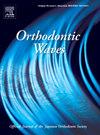Improvement of binding friction between stainless steel orthodontic wire and bracket by performing Rh-PTFE composite plating on the wire
IF 0.5
Q4 DENTISTRY, ORAL SURGERY & MEDICINE
引用次数: 0
Abstract
ABSTRACT Purpose: During orthodontic treatment, it is important to ensure that the least frictional force is applied to the teeth to ensure optimal tooth movement. We applied electrolytic rhodium-polytetrafluoroethylene (Rh-PTFE) composite plating to stainless steel (SS) orthodontic wires with the aim of suppressing friction and corrosion in the wire and facilitating the longevity of treatment. Materials and methods: SS orthodontic wires were plated with a polytetrafluoroethylene (PTFE) particle suspended solution. The surface colour was changed to black with Rh-PTFE plating, and a homogeneous distribution of PTFE particles was observed in the plated layer using scanning electron microscopy (SEM). Results: The friction of Rh-PTFE plated wire with the SS bracket decreased to ½ to 1/3rd of the original force by increasing the PTFE content in the plated layer, despite the increase in surface roughness with plating. Corrosion suppression was also observed when Rh-PTFE plating was applied to a nickel wire. Conclusion: Ensuring smooth movement between the wire and bracket decreases the risk of metal dissolution, which can be effectively be achieved with Rh-PTFE plating. This finding will significantly assist orthodontists in choosing plated wires to ensure a more effective course of treatment for their patients in the future.Rh-PTFE复合镀层改善不锈钢正畸丝与托槽结合摩擦
摘要目的:在正畸治疗过程中,重要的是确保施加在牙齿上的摩擦力最小,以确保牙齿的最佳运动。我们将电解铑-聚四氟乙烯(Rh-PTFE)复合镀层应用于不锈钢(SS)正畸丝,目的是抑制丝中的摩擦和腐蚀,延长治疗寿命。材料和方法:采用聚四氟乙烯颗粒悬浮液对SS正畸丝进行镀敷。通过Rh-PTFE镀层,表面颜色变为黑色,并且使用扫描电子显微镜(SEM)在镀层中观察到PTFE颗粒的均匀分布。结果:尽管镀层表面粗糙度增加,但通过增加镀层中PTFE的含量,Rh-PTFE镀层丝与SS支架的摩擦力降至原始力的½至1/3。当将Rh-PTFE镀层应用于镍线时,也观察到腐蚀抑制。结论:确保金属丝和支架之间的平稳移动可以降低金属溶解的风险,Rh-PTFE镀层可以有效地实现这一点。这一发现将大大有助于正畸医生选择电镀金属丝,以确保未来为患者提供更有效的治疗方案。
本文章由计算机程序翻译,如有差异,请以英文原文为准。
求助全文
约1分钟内获得全文
求助全文
来源期刊

Orthodontic Waves
DENTISTRY, ORAL SURGERY & MEDICINE-
CiteScore
0.40
自引率
0.00%
发文量
0
期刊介绍:
Orthodontic Waves is the official publication of the Japanese Orthodontic Society. The aim of this journal is to foster the advancement of orthodontic research and practice. The journal seeks to publish original articles (i) definitive reports of wide interest to the orthodontic community, (ii) Case Reports and (iii) Short Communications. Research papers stand on the scientific basis of orthodontics. Clinical topics covered include all techniques and approaches to treatment planning. All submissions are subject to peer review.
 求助内容:
求助内容: 应助结果提醒方式:
应助结果提醒方式:


